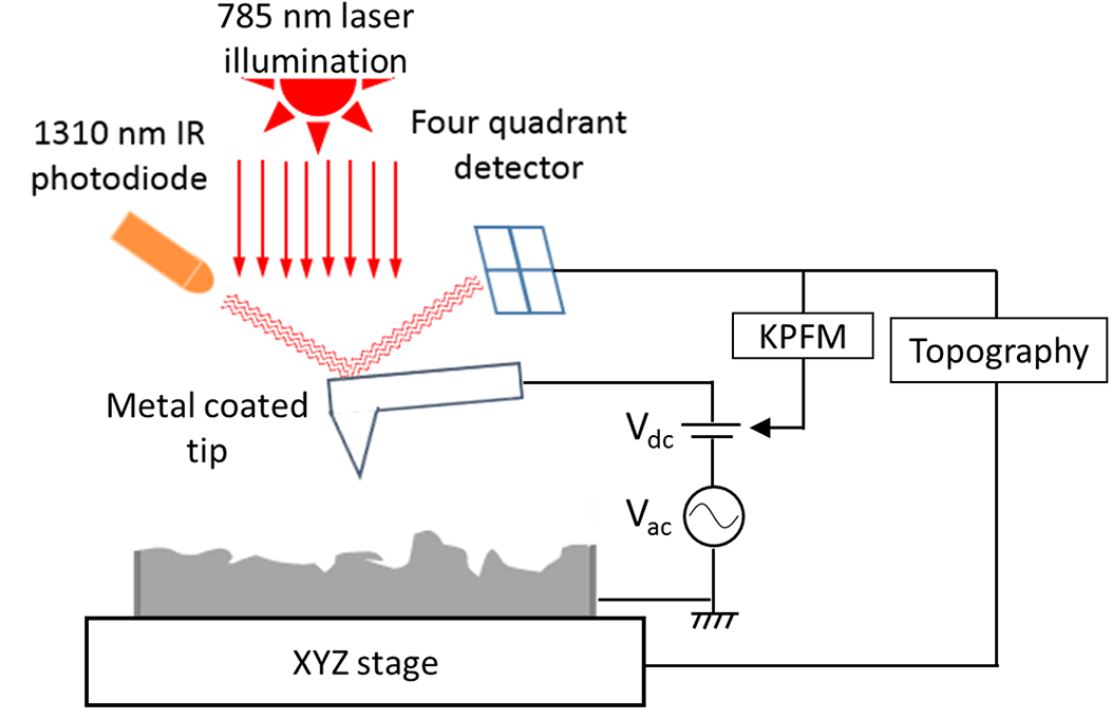The development of photovoltaic (PV) technologies has progressed significantly over the past twenty years as a result of considerable advancements in solar cell device engineering and material science. *
As a consequence, solar cells have turned into complex structures containing numerous layers and interfaces. The capability to conduct local investigations at the nanoscale level that provide information on the electrical properties of materials and along physical interfaces is becoming crucial for solar photovoltaic device efficiency improvement. *
The capability to conduct local investigations at the nanoscale level that provide information on the electrical properties of materials and along physical interfaces is becoming crucial for solar photovoltaic device efficiency improvement. *
Multilayer III–V-based solar cells are complex devices consisting of many layers and interfaces. *
The study and the comprehension of the mechanisms that take place at the interfaces is crucial for efficiency improvement. *
Electrical measurements based on scanning probe microscopy (SPM) allow for the analysis of two-dimensional (2D) features at the surface and along a physical cross section of nanoscale semiconductor structures. *
Among the wide variety of SPM techniques available, Kelvin probe force microscopy (KPFM) is an application of the atomic force microscope (AFM) for the evaluation of the surface potential with nanometric resolution. KPFM is a valuable investigative approach for the study of work functions via the measurement of the contact potential difference VCPD, that is, the difference between the electrostatic potential at the surface of the investigated structure and that of the KPFM probe. *
In the article “Cross-sectional Kelvin probe force microscopy on III–V epitaxial multilayer stacks: challenges and perspectives” Mattia da Lisca, José Alvarez, James P. Connolly, Nicolas Vaissiere, Karim Mekhazni, Jean Decobert and Jean-Paul Kleider apply frequency-modulated Kelvin probe force microscopy (FM-KPFM) under ambient conditions to investigate the capability of this technique for the analysis of an InP/GaInAs(P) multilayer stack. *
KPFM reveals a strong dependence on the local doping concentration, allowing for the detection of the surface potential of layers with a resolution as low as 20 nm. *
The analysis of the surface potential allowed for the identification of space charge regions and, thus, the presence of several junctions along the stack. Furthermore, a contrast enhancement in the surface potential image was observed when KPFM was performed under illumination, which is analysed in terms of the reduction of surface band bending induced by surface defects by photogenerated carrier distributions. The analysis of the KPFM data was assisted by means of theoretical modelling simulating the energy bands profile and KPFM measurements. *
KPFM was performed using a scanning probe microscopy system under ambient conditions and operated in the frequency-modulated KPFM (FM-KPFM) mode using a two-pass scanning mode, where the second pass was performed at a constant distance of 10 nm from the sample surface. *
The FM-KPFM mode was chosen over the amplitude-modulation mode (AM-KPFM) since it is well known that it provides better spatial resolution. In particular, in AM-KPFM the electrical force between the tip and the sample is directly evaluated, whereas in FM-KPFM the gradient of the force is analysed. As a result, FM-KPFM is more sensitive to local tip apex–sample surface interactions; therefore, long-range electrostatic interactions of the cantilever are reduced, as well as the effect of parasitic capacitances. Additionally, in FM-KPFM, surface potential measurements are less dependent on the lift-height tip–sample distance than in AM-KPFM since this mode is less sensitive to static offsets induced by capacitive coupling or crosstalk. *
The laser beam deflection system in the author’s AFM employs a laser wavelength of 1310 nm, which is well below the bandgap of the sample; therefore, the parasitic laser absorption, which may interfere with the KPFM measurement, is reduced to negligible levels. Highly doped NanoWorld n+-Si ARROW-EFM tips (typical AFM tip radius < 25 nm) with a conductive Pt/Ir coating at a typical resonance frequency of 75 kHz were used. *

KPFM measurement under ambient conditions on the surface cross section of the sample under illumination: (a) topography and (b) VCPD image. A vertical coloured bar is included to ease the identification of the different layers. The profile in (c) corresponds to the region identified by the dotted white segments in (b), each point of the profile (vertical) direction being an average of 207 points over a width of 0.7 μm along the x axis. Several regions along the structure have been highlighted using different colours (see text). The black arrow indicates the space charge region at the InP:nid/InP:Zn interface.
*Mattia da Lisca, José Alvarez, James P. Connolly, Nicolas Vaissiere, Karim Mekhazni, Jean Decobert and Jean-Paul Kleider
Cross-sectional Kelvin probe force microscopy on III–V epitaxial multilayer stacks: challenges and perspectives
Beilstein Journal of Nanotechnology 2023, 14, 725–737
DOI: https://doi.org/10.3762/bjnano.14.59
The article “Cross-sectional Kelvin probe force microscopy on III–V epitaxial multilayer stacks: challenges and perspectives” by Mattia da Lisca, José Alvarez, James P. Connolly, Nicolas Vaissiere, Karim Mekhazni, Jean Decobert and Jean-Paul Kleider is licensed under a Creative Commons Attribution 4.0 International License, which permits use, sharing, adaptation, distribution and reproduction in any medium or format, as long as you give appropriate credit to the original author(s) and the source, provide a link to the Creative Commons license, and indicate if changes were made. The images or other third-party material in this article are included in the article’s Creative Commons license, unless indicated otherwise in a credit line to the material. If material is not included in the article’s Creative Commons license and your intended use is not permitted by statutory regulation or exceeds the permitted use, you will need to obtain permission directly from the copyright holder. To view a copy of this license, visit https://creativecommons.org/licenses/by/4.0/.

